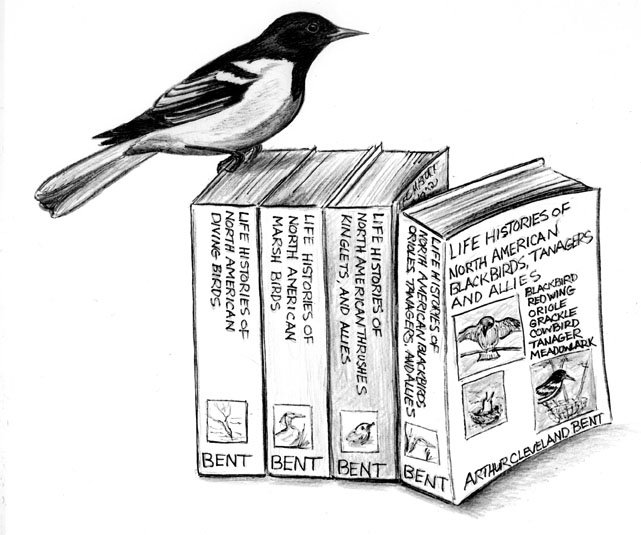
Dear Bird Folks,
I’m sure you are familiar with most of the current bird experts, but I’m wondering if you have ever heard of my great-grandfather. His name is Arthur Cleveland Bent. He wrote a twenty-one-volume set of books about North American birds. Ever hear of him? –
Wendy -Marstons Mills, MA
Wow, Wendy,
Your great-grandfather was Arthur Cleveland Bent? How awesome is that? I never met my great-grandfather, but I’m pretty sure he never wrote any bird books. In fact, I don’t think he did anything that would make him famous, except for maybe drinking. I hear he was pretty darn good at that.
I don’t know what it is about Massachusetts, but it seems to be a magnet for birding icons. Most people think I’m the only regional birding legend, but there were others. Roger Tory Peterson taught science in the town of Brookline. David Sibley lives in historic Concord. And I think John James Audubon once saw Massachusetts on a map. Arthur Cleveland Bent (ACB), who spent most of his life living in America’s birding mecca, Taunton, MA, isn’t as well known as the others. I think the reason for his lack of fame is, unlike Peterson, Sibley and Audubon, ACB wasn’t a master artist. He was more like me – a birder, plus a wizard in the business world. ACB became successfully involved in the early days of the power industry. I, of course, started a worldwide chain of bird watching specialty shops, which at last count was up to one store.
Born in 1866, ACB wasn’t the healthiest kid on the block, so his dad (your great-great grandfather, Wendy) forced him to stop watching TV and took him on long hikes to help build up his strength. It was during these hikes that Bent first became interested in birds. But finding birds outside the borders of Taunton was a challenge for someone of his young age. Back in the 1800s travel was limited. There were no cars, buses or even Segways to transport birders to different birding habitats. The occasional birding trip to Fall River, MA was the best he could hope for. A big birding trip to Fall River? Man, that must have been a real long time ago.
After high school Bent attended Harvard, where he discovered that he had a flair for business. He eventually went on to form the Plymouth Electric Light Company, which he ran for the next thirty years. His success at the PELC allowed him to take regular birding excursions. ACB traveled throughout much of North America studying and collecting birds. The idea of “collecting,” which is shooting birds in order to study them more closely, seems a little disturbing in the 21st century. But back then there were few decent binoculars and no digital cameras with telephoto lenses to capture bird images. Whoever wanted to see a bird up close, used a shotgun.
It didn’t take long before ACB was recognized as one of North America’s leading authorities on birds. He became associated with the Smithsonian Institution, National Audubon Society, Harvard’s Museum of Comparative Zoology…and Madeleine Vincent Godfrey. Who’s Madeleine Vincent Godfrey? She’s your great-grandmother, Wendy. But ACB’s most important achievement, at least in the bird world, was the publication of the Life Histories of North American Birds. In his twenty-one-volume anthology Bent discusses, in great length, the natural history of the birds of our continent. If you want to know how many eggs cardinals lay, what Mallards eat, what a goldfinch nest is made of, or how much milk cowbirds give, it’s all in there.
And while the breadth of this work is an astounding accomplishment, what impresses me is the way in which it is written. Most nature writers, myself included, add to their personal knowledge by incorporating information from other sources. (It’s kind of like plagiarizing, but not exactly…hopefully.) Bent not only acknowledged other sources right on the page, but he added transcripts of the actual notes from other observers. So, for example, if he received a letter from Maggie Jackson, stating that she saw bluebirds eating her homemade chocolate chip cookies, his book would report: “According to Mrs. Jackson, Eastern Bluebirds eat her chocolate chip cookies.” He allowed both professionals and laypeople to contribute to the text in his books. In all there were over 800 people, from all walks of life, who contributed to the Life Histories of North American Birds. Arthur Cleveland Bent, in a sense, created the very first Wikipedia. Your great-grandfather was way ahead of his time, Wendy.
The Life Histories of North American Birds is Bent’s life long work. The first volume was released in 1919. The last wasn’t completed until 1968, fourteen years after his death. The final volume was finished with the help of yet another Massachusetts birder, famed ornithologist Oliver Austin, Jr., who once ran a bird banding station on the site of what is now the home of the Wellfleet Bay Wildlife Sanctuary. Unfortunately, Bent’s books are no longer in print. There is good news, though. Most of ACB’s work can be read online at birdsbybent.com. However, if you want hard copies you’ll have to look in used bookshops or yard sales. Just don’t expect to see me at any of those places. I spend all my free time looking for Mrs. Jackson’s house. If she’s handing out free chocolate chip cookies, I want to be in on it.